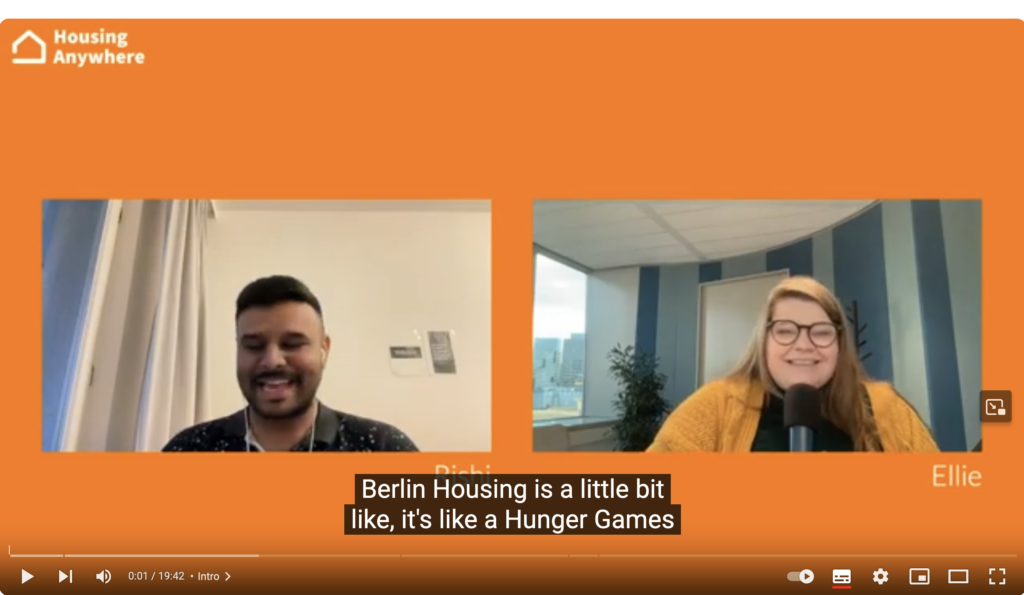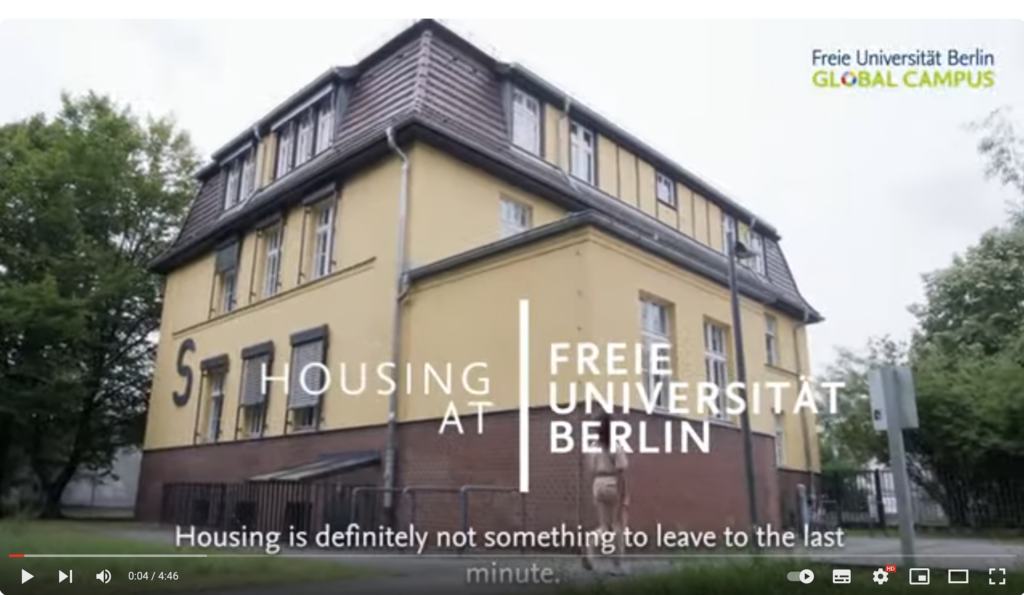In this seminar, a group of international students from the HU Master’s programs in Asian/African Studies, Gender Studies, Global Studies and History (both MA and BA) explored the methodological approach of visual domestic ethnography as it has been theorized by film scholar Michael Renov and later on extended by Nariman Massoumi and other authors & filmmakers. The students applied this approach to selected autobiographical family films by South Asian film directors made since the end of the 1990s. Their posters were created as part of our seminar. They also contain QR codes that can be used to view the films examined online.
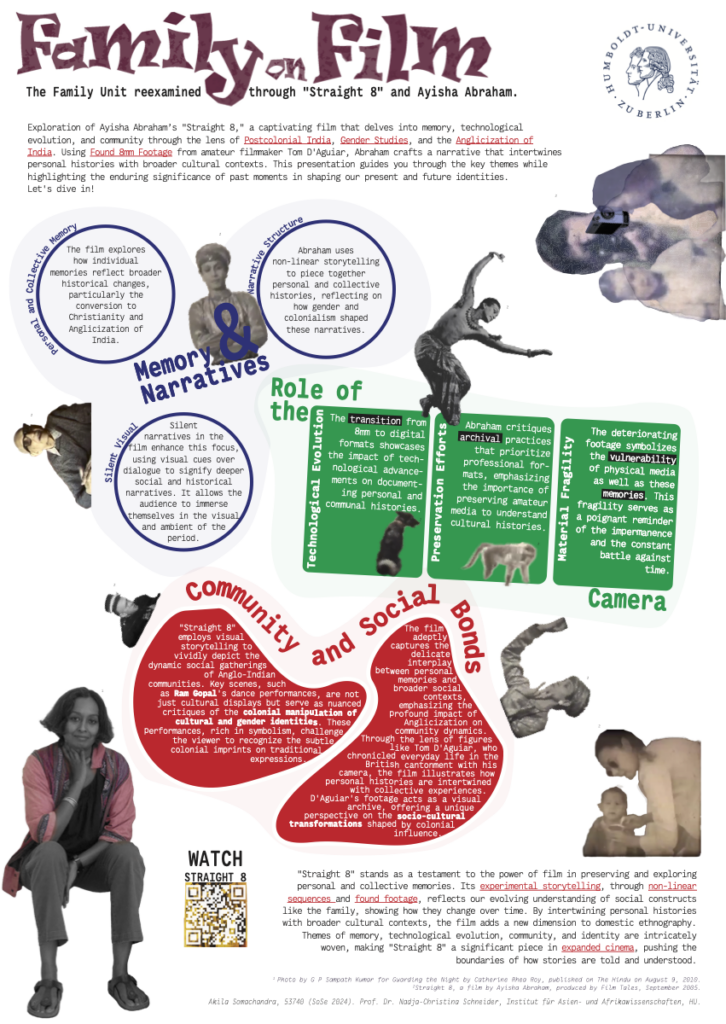
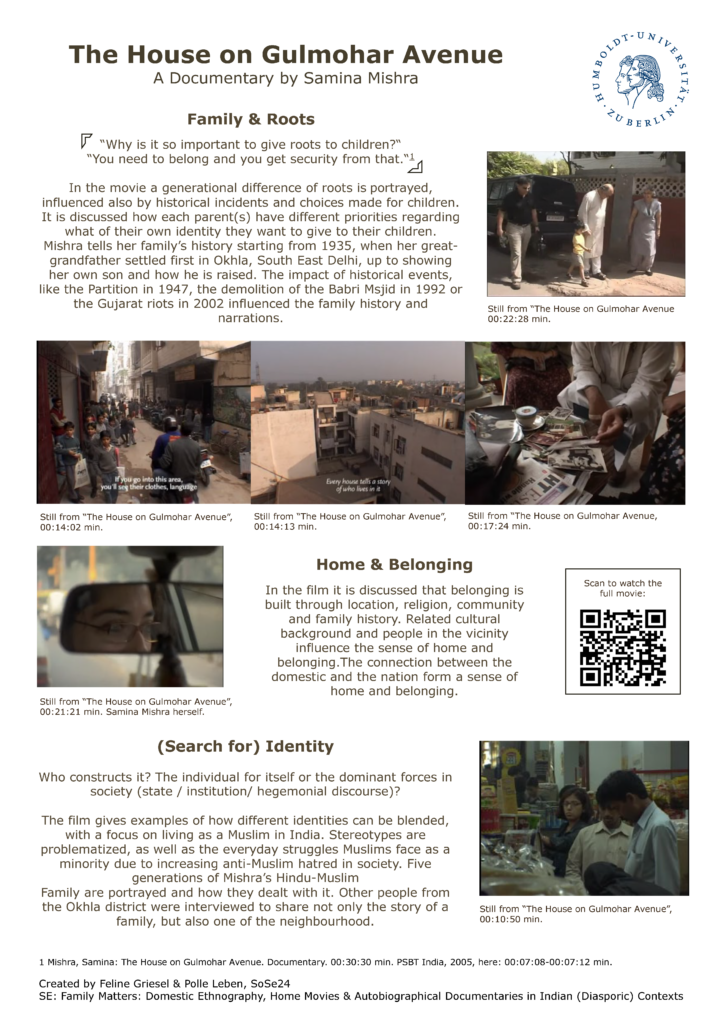
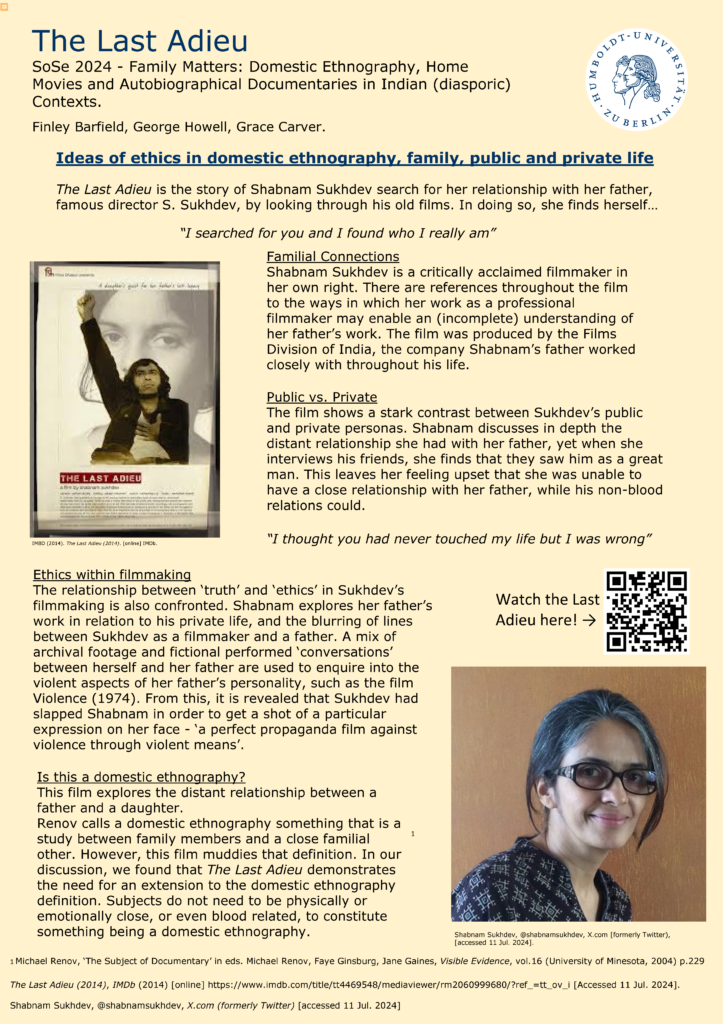
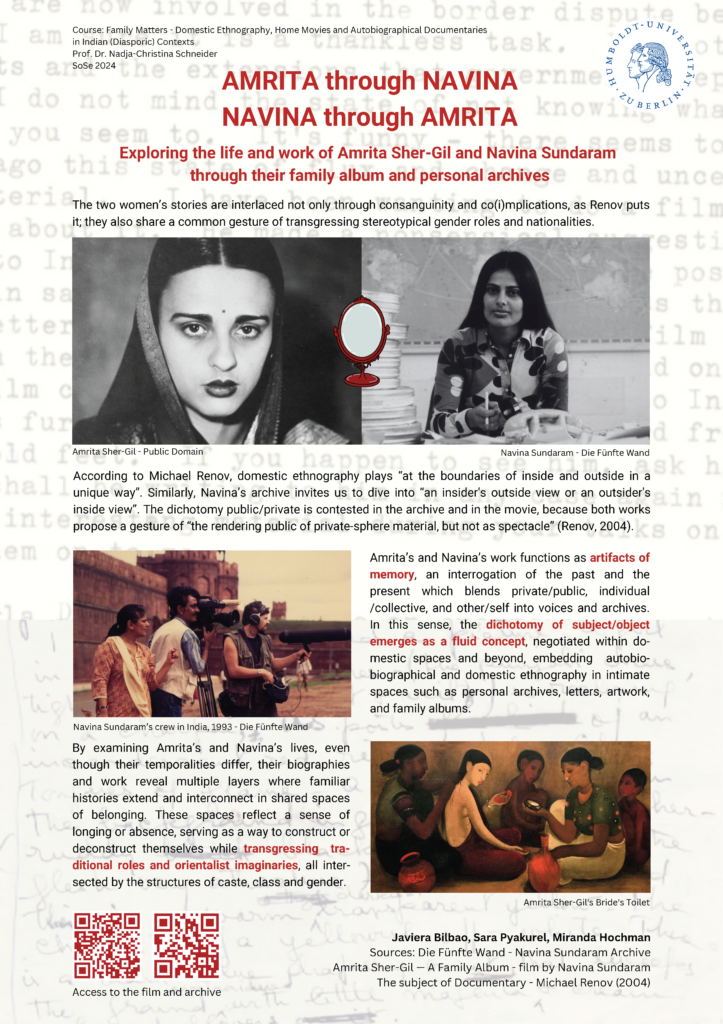
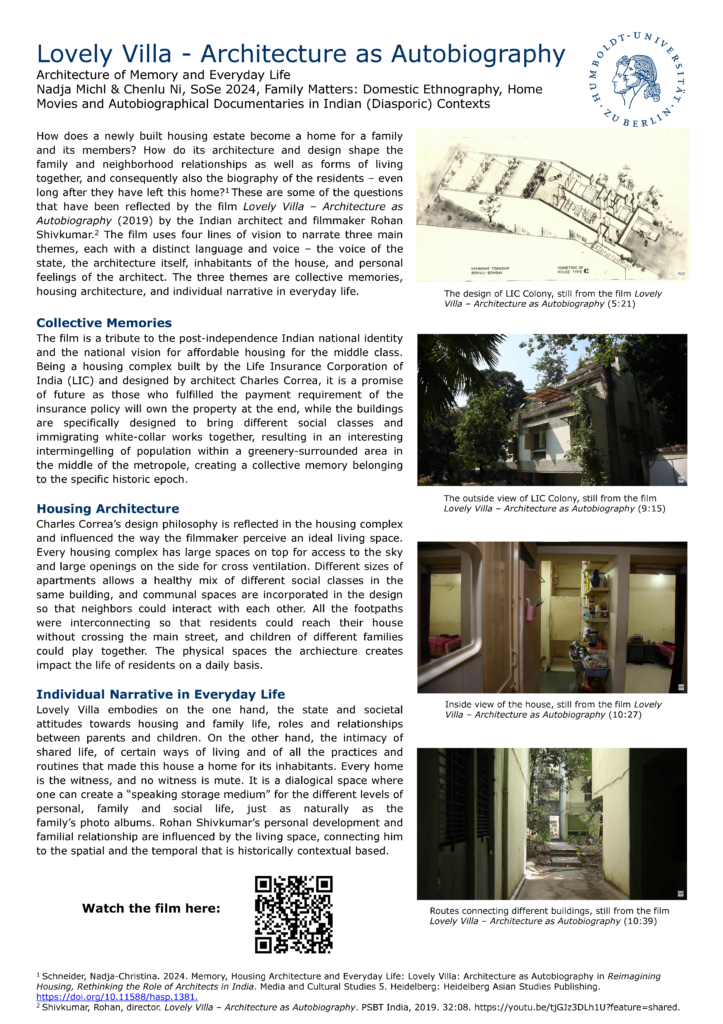
Studentische Wohnungsnot in Berlin
von Nadja-Christina Schneider1
Für Studierende wird es in einer Stadt wie Berlin seit Jahren immer schwieriger, eine bezahlbare Unterkunft zu finden. Lange Wartelisten für Wohnheimplätze, die WG-Zimmersuche als herausfordernder Casting-Wettbewerb und für viele kaum bezahlbare Mieten. Wohnen „außerhalb“ ist bekanntlich keine attraktive Alternative für junge Menschen, die es in dieser besonders prägenden Phase ihres Lebens in die Großstadt zieht. Lange Anfahrtswege, eine mitunter schlechte Anbindung an öffentliche Verkehrsmittel und das Fehlen anderer wichtiger Infrastrukturen des täglichen Lebens möchten viele ebenfalls nicht in Kauf nehmen. Inmitten der allgemeinen Wohnungsnot in Berlin fange „die studentische Wohnungskrise erst an“, so formulierte es der Tagesspiegel am 22. Dezember 2022.
Wie David Madden und Peter Marcuse in ihrem gemeinsam verfassten Buch In Defense of Housing (2016) kritisieren, vermittelt der vielzitierte Begriff der Wohnungskrise, dass es sich lediglich um eine temporäre Abweichung von einem ansonsten weitaus besseren Normalzustand handele, der mit den richtigen Maßnahmen wiederhergestellt werden könnte, wie es insbesondere die politische Rhetorik nahelegt.2[1] Madden und Marcuse erinnern jedoch daran, dass bereits Friedrich Engels in seinen Überlegungen zur Wohnungsfrage (1887) erkannt hatte, für welche gesellschaftlichen Gruppen diese „Krise“ zu allen Zeiten tatsächlich den Normalzustand darstellt:
„The so-called housing shortage, which plays such a great role in the press nowadays, does not consist in the fact that the working class generally lives in bad, overcrowded or unhealthy dwellings. This shortage is not something peculiar to the present; it is not even one of the sufferings peculiar to the modern proletariat in contradistinction to all earlier oppressed classes. On the contrary, all oppressed classes in all periods suffered more or less uniformly from it (F. Engels (1872). The Housing Question, zitiert in Madden & Marcuse 2016: 9).”
Die neue Wohnungsfrage im Berlin des 21. Jahrhunderts ist in den sog. klassischen Medien durchaus sichtbar, aber es fällt schnell auf, welche gesellschaftlichen Gruppen keine besonders hohe mediale Aufmerksamkeit erhalten. Studierende gehören ohne Zweifel dazu, denn abgesehen von einigen Schlagzeilen und Zeitungsberichten, welche regelmäßig zum Semesterbeginn zu finden sind, hält sich die Berichterstattung zur studentischen Wohnungsnot in der deutschen Hauptstadt in Grenzen.
Woran könnte das liegen, zumal in einer Stadt, die sich als „engagierte, exzellente und internationale Brain City“ beziehungsweise als „innovative Wissensmetropole“ versteht und in der es in der Tat eine beachtliche Zahl an öffentlichen und privaten Universitäten sowie Hochschulen gibt? Nach Angaben der Berliner Senatsseiten forschen, lehren, arbeiten und studieren „an den elf staatlichen, zwei konfessionellen und rund 30 staatlich anerkannten Hochschulen in Berlin über 250.000 Menschen aus aller Welt.“3[2] Wie finden all diese Hochschulangehörigen ihren bezahlbaren Wohnraum in Berlin und wo wohnen sie?
Auch ein Blick auf die zentralen Webseiten der drei großen Berliner Universitäten TU, HU und FU weist das Thema studentisches Wohnen und die Wohnungsnot der Studierenden nicht als eines aus, für das sich die Bildungseinrichtungen selbst in zentraler Verantwortung sehen oder über das sie sonderlich viel zu berichten hätten. Die wenigen auffindbaren Informationen richten sich vorwiegend an internationale Studierende oder verweisen auf die Angebote des Studierendenwerks bzw. im Fall der HU auf den Campus in Adlershof. Wie Judith Thomsen in ihrer Studie zu „Home Experiences in Student Housing“ (2007) mit Bezug auf Norwegen erwähnt, werden Unterkünfte für ihre Studierenden nicht nur in Deutschland, sondern auch in Skandinavien traditionell nicht als Bereich betrachtet, für den die Universitäten als verantwortlich gesehen werden. Sie führt jedoch Großbritannien als Beispiel für einige westeuropäische Länder an, in denen „university-provided student housing“ zumindest über längere Zeiträume existierten (Thomsen 2007: 578).
Da studentisches Wohnen in Berlin offenbar weiterhin als ein Bereich betrachtet wird, der buchstäblich „außerhalb“ der Universität liegt, müssen Studierende selbst eine Lösung hierfür finden. Gelingt es nicht, wird dies von jungen Menschen häufig als „Scheitern“ oder ungewollte Rückkehr in die Phase der Adoleszenz wahrgenommen. Besonders deutlich wurde dies in der Pandemie-Situation, in der sich Studierende in hoher Zahl gezwungen sehen, wieder bei ihren Eltern und vielfach in ihr altes Kinderzimmer einzuziehen, das nach ihrem Auszug eigentlich für ihre Wochenendbesuche oder andere Zwecke genutzt werden sollte. Für viele Studierende auf Wohnungssuche in Berlin, darunter ein hoher Anteil an internationalen Studierenden, gab und gibt es jedoch nicht einmal diese Option eines „Zurück zu…“ oder sie versuchen, den Wegzug aus der Stadt, in die sie mit so vielen Hoffnungen und Erwartungen gekommen sind, doch noch irgendwie abwenden zu können. Es ist ein sehr wichtiger Schritt, dass wir an den Berliner Universitäten mittlerweile immer mehr Bewusstsein und auch Angebote für zentrale Fragen der mentalen Gesundheit von Studierenden bereitstellen. Doch wir verknüpfen diese bislang noch nicht mit der außerordentlich hohen Belastung, der sie in vielen Fällen in erster Linie aufgrund ihrer Wohnsituation und finanziellen Probleme und möglicherweise nicht primär durch ihr Studium ausgesetzt sind.
Im deutlichen Kontrast zur Abwesenheit der Wohnungsnot von Studierenden in den „klassischen“ Medien weisen soziale Medien und Plattformen wie YouTube neuerdings eine wachsende Zahl an hochgeladenen Beiträgen zu diesem Thema auf. Darin lassen sich wiederum unterschiedlichste Formate und damit verknüpfte Medienpraktiken feststellen, welche von einer medialen Selbstpräsentation der Studierenden und Thematisierung ihrer aktuellen Wohnsituation oder verzweifelten Suche über dialogische Formate und Tipps für andere Studierende bis zu einfach hochgeladenen Videos mit Informationen und Testimonial-Berichten reichen können. Auffallend ist auch hier, dass sich viele der Austausch- und Informationsangebote gezielt an internationale Studierende in Berlin richten.
Home Abroad Podcast: Student Accommodation in Berlin
Rishi: „Berlin Housing is a little bit like a Hunger Games.”
Ellie: “Hahaha. Fight to the death for it.”
Eines der am häufigsten aufgerufenen Beispiele hierfür ist ein knapp fünfminütiges Video, das für internationale Studierende an der Freien Universität produziert wurde und sich überwiegend auf studentische Unterkünfte im Südwesten Berlins bezieht. Neben Studentenwohnheimen und der Unterbringung in Gastfamilien sowie einem kurzen Abstecher an den Alexanderplatz zum kommerziellen The Social Hub (früher The Student Hotel) wird hier das Studentendorf Schlachtensee vorgestellt, nach dessen Vorbild für HU-Studierende das Studentendorf Adlershof neu erbaut wurde. Die interviewte Bewohnerin im FU-Video verrät uns, dass heute überwiegend internationale Studierende im Studentendorf in Schlachtensee ihre temporäre Unterkunft in Berlin finden – ursprünglich errichtet wurde es in der Nachkriegszeit jedoch nicht nur, um dort Studierende der FU unterbringen zu können, sondern auch, um im Rahmen der US-amerikanischen Maßnahmen zur Reeducation junge Menschen in der Bundesrepublik an die Demokratie heranzuführen.
Die Architektur und Raumplanung des Studentendorfes Schlachtensee sollte also dafür Sorge tragen, dass junge Studierende als zentrale Akteursgruppe der bundesdeutschen Nachkriegsgesellschaft lernen, demokratisch zusammen zu leben. Dies mag aus heutiger Sicht als Form eines „social engineering“ und Ausdruck einer top-down-Planung kritisch betrachtet werden. Gerade mit Blick auf den „hyperkommodifizierten“ städtischen Wohnungsmarkt der Gegenwart (Madden & Marcuse 2016: 39) wirft es aber auch die Frage auf, wie die Gesellschaft und Politik eigentlich heute auf die Studierenden und ihre Rolle blickt, und ob sie nicht nur für die Notwendigkeit des studentischen Wohnens erneut sensibilisiert werden könnte, sondern vor allem auch für das positive Potenzial gemeinschaftlichen Wohnens als Erfahrung und eingeübte Praxis, die zu Formen eines gutes Zusammenleben in der Gesellschaft beitragen kann.
Zitierte Literatur
Madden, David and Peter Marcuse (2016). In Defense of Housing. London/New York: Verso.
Thomsen, Judith (2007). “Home Experiences in Student Housing: About Institutional Character and Temporary Homes”. Journal of Youth Studies, 10:5, 577-596.
Über die Autorin
Nadja-Christina Schneider ist Südasienwissenschaftlerin und arbeitet am Institut für Asien- und Afrikawissenschaften. Mit dem Thema bezahlbarer Wohnraum, Architektur und Zusammenleben befasst sie sich seit einigen Jahren intensiver.
- Dieser Text ist aus einer gemeinsamen Schreibübung mit Master-Studierenden hervorgegangen, die wir im Sommersememster 2023 zum Thema studentisches Wohnen, Zusammenleben und bezahlbarer Wohnraum in Berlin im Rahmen eines Seminars durchgeführt haben. Der ebenfalls in diesem Blog veröffentlichte Beitrag von İnci Nazlıcan Sağırbaşbaş zum Thema „Making a Home in Berlin: Navigating a Housing Crisis as an International Student“ ist auch aus dieser Schreibübung im Rahmen unseres Seminars hervorgegangen. ↩︎
- „Klara Geywitz, Bundesministerin für Wohnen, Stadtentwicklung und Bauwesen: ‚Zum ersten Mal gibt es im Rahmen des sozialen Wohnungsbaus ein Förderprogramm nur für junge Menschen in Ausbildung. Sie sollen sich vor allem auf ihre Ausbildung konzentrieren und nicht wochen- oder gar monatelang auf Wohnungssuche sein. Mit einer halben Milliarde Euro können die Länder jetzt Wohnheimplätze neu- oder umbauen, um junge Menschen in die Region zu holen oder zu halten. Damit wird der Standort Deutschland insgesamt attraktiv für junges Knowhow, aber auch die einzelnen Regionen profitieren erheblich. Wer einmal da ist, bleibt vielleicht. Wie gut man Wohnraum findet, den sich jeder leisten kann, ist dabei ein entscheidender Faktor. Mit diesem gezielten Fokus auf Junges Wohnen werden wir sicher schnell Erfolge erzielen‘ („Bezahlbarer Wohnraum für junge Menschen: Sonderprogramm Junges Wohnen gestartet!“ https://www.studentenwerke.de/de/content/bezahlbarer-wohnraum-fue-junge-menschen).“ (10.06.2023) ↩︎
- Senatsverwaltung für Wissenschaft, Gesundheit und Pflege: Wissenschaft und Forschung: Hochschulen. https://www.berlin.de/sen/wissenschaft/einrichtungen/hochschulen/ (10.06.2023). ↩︎
By İnci Nazlıcan Sağırbaşbaş
Regardless of our backgrounds, the concept of home is central to our belonging, it is a matter of feeling comfortable and safer. While the emerging housing crisis in Berlin results in a massive housing shortage, high rent prices, informal housing arrangements, and unjust rental procedures for almost everyone, it adds to the vulnerability of international students who are already in discriminatory and structurally challenging processes. Newly arrived international students are bound to go through various difficulties in finding a relatively stable or affordable place while also struggling with the barriers of language, law, and bureaucracy. They have to constantly navigate the various stereotypes ingrained in people’s minds, while not having the possibility of having a permanent place to live or basic utilities such as ‘a possibility of Anmeldung’.
I want to talk in particular about the experiences of finding a home in Berlin through online portals and the perceptions of the city for some international students through their various practices of home-making. How do these practices of ‘making a home’ such as finding an accommodation, settlement, building support networks, and dealing with the bureaucracy outline and influence the sense of belonging in the city? The process supporting this essay comprises auto-ethnographic research and semi-structured in-depth interviews with a homogeneous sample of international students. The following questions were asked according to the way conversations proceed: What were the biggest obstacles for you in finding housing? How did the process make you feel? What help did you get? How do you think your identity as an immigrant and a student has affected the outcomes? In total, 8 people were interviewed, 6 women and 2 men, all non-EU citizens and from middle-upper classes. The interviews provided limited data on personal and collective behaviors and trajectories while considering the complexity of the relationship between the immigrant’s experience in the city and the role of home-making.
‘While I was looking for an apartment I sent hundreds of messages without any reply, however when my partner with her German last name sent a few messages she got several replies and that’s how we found our first place.’
I, like most of my fellow international students, have looked at and applied to countless flatshares during my first months in Berlin. It became an automatic act to check new offers, answer questions, and send motivational, desperately positive, and personal messages to complete strangers on a daily basis. It was the first thing I did in the morning and the last in the evening. There were several identities crashing into each other in my mind, and I was struggling to describe who I was for the prospective flatmates who were so confident in their attempts to categorize us. With one short paragraph or two, we needed to build trust, find the correct length, and leave a positive memory. The pressure this task creates is overwhelming and non-ending. But, we were actively and collectively forming solidarities and making Berlin our home while we were searching for the houses that would contain our bodies and lives. The collectivity of the struggle and the humor that surrounded this practice of looking for a home in Berlin was one of the few things that made the anxiety of being without a stable place better.
‘The feeling that Berlin is full of immigrants also makes me feel like I’m not the only one in the same situation.’
The portals like ‘wg-gesucht’ are constantly building a collective memory of the housing crisis in Berlin which is steadily getting worse in the last couple of years. But after the months we spent on those websites and finally finding a flat in Berlin, what else does this experience teach us? What do we gain and lose, create and waste with all the time and effort we put into this? The main findings of the interviews showed that people from similar backgrounds or ethnicities were creating the main support systems and ‘arrival structures’ for the newcomers such as the established diaspora, old colleagues, or friends of friends. As well as more anonymous sources such as Reddit threads and Facebook, WhatsApp, or Telegram groups. These informal and mostly online practices were elements almost everyone utilized.
The last-minute changes and fast-paced nature of searching for a home in Berlin made it into a side job for most of us. We created fluid identities around requirements like a vegan diet, undying love of techno music, or open-door rules while the prospective flatmates were trying to navigate through the flood of hundreds of applications. We felt isolated, rejected, and without a community after hundreds of tries without getting any answers back while they were feeling confused, overwhelmed, and guilty. We were stuck in a type of “permanent temporariness” (Steigemann & Misselwitz, 2020) marked by uncertainty and exclusion as the outcomes of neo-liberal politics in Berlin. Maybe because we were privileged with our middle-upper class backgrounds and student identities, we all found a way to stay in Berlin. Now, when I asked ‘How do you feel about it now?’ to the interviewees, the memories of anxiety and stress faded into funny stories and anecdotes. But, even though the memories are almost always subjective, situated, and temporal, it doesn’t mean they are any less valuable.
‘Having some friends here and knowing the language helped me. Since I lived in Germany before, I already knew small stuff like the labels and brands of my favorite yogurt or toothpaste. Little things that make you feel at home.’
The temporalities of making a home in Berlin heavily affect our engagement in our daily practices and perception of the city. Our experiences as immigrants in a new country and city rely on our routines and daily life creating a ‘practical consciousness’ (Giddens, 1991). The findings reveal that the dynamic character of home-making and sense of belonging is also unilinear and temporal. Language and social citizenship are indicators of the more structural aspects of belonging with attention to individuality and ethnic backgrounds. However, an immigrant’s incapability to exercise their agency in everyday social practices results in a lack of self-confidence and a sense of disappointment. Despite these feelings, we actively make a home in Berlin while establishing relations and seeking security, control, and continuity.
‘I think it helps to be a student because you have the back of a whole university, so it’s easy to accredit why you migrated here. It is also very helpful to speak the language because they don’t notice you are new in town and act friendlier at the public offices. On the other hand, you are able to apply for social housing or any contract directly in your name.’
The initial struggles of migration make us focus almost entirely on finding an apartment and livelihood more than the socio-cultural relations we need to build to call somewhere home. However, through the struggles with our agencies, practices, and solidarities; many of us already started calling Berlin our new home. As an urban designer and architect from Turkey, the ghost stories of squatting movements and migrant struggles in Berlin were hanging at the back of my brain during these last months. Although Germany prides itself in free education and Berlin is known to be a hub for internationals from all over the world, it may soon only be open to a select and wealthy few, and the diasporic roots, solidarity groups, and the movements against the housing crisis may not be enough to make Berlin our new home.

Bibliography
Boccagni, P. (2017). Migration and the Search for Home: Mapping Domestic Space in Migrants’ Everyday Lives. Palgrave Macmillan US. https://doi.org/10.1057/978-1-137-58802-9
Giddens, A. (1991). Modernity and Self-identity: Self and Society in the Late Modern Age. Stanford University Press. Retrieved from https://books.google.de/books?id=Jujn_YrD6DsC
Hamann, U. & Türkmen, C. (2020) Communities of struggle: the making of a protest movement around housing, migration and racism beyond identity politics in Berlin, Territory, Politics, Governance, 8:4, 515-531, DOI: 10.1080/21622671.2020.1719191
Smith, E. (2022) Student Experiences of Berlin’s Housing Crisis, https://berlinspectator.com/2022/05/15/erica-smith-student-experiences-of-berlins-housing-crisis/
Steigemann, A. & Misselwitz, P. (2020) . Architectures of asylum: Making home in a state of permanent temporariness. Current Sociology, Special Issue: Researching Home: Choices, Challenges, Opportunities, pp. 628-650.
About the author
İnci graduated with a Bachelor’s degree in Architecture from Izmir Institute of Technology in Turkey. She studied at the University of Ferrara and Hochschule Koblenz as an exchange student. She later assumed a research position at the Architecture and Urbanism Research Academy Istanbul where she focused on engaging with different bodies and ways of living together with urban animals through informal design practices. She is resuming her studies in the Urban Design Master program at TU Berlin while taking part in several local and student initiatives such as Nesin İstasyon in Izmir and ifa_diaspora in Berlin.
Nadja-Christina Schneider
Uday Berry’s nearly eleven-minute animated short film Bharat Minar. The Tower of a Forgotten India (2019) won the Best Fiction Short category at the 2021 Architectural Film Festival in London. The film festival “showcases the cross-pollination of architecture and filmmaking, exploring the evolving scope of each discipline”. Berry is a trained architect and graduated from the Bartlett School of Architecture (UCL) in 2019, where he was part of a project group (PG24) of architectural storytellers, led by Penelope Haralambidou and Michael Tite, which uses “film, animation, VR/AR and physical modelling techniques to explore architecture’s relationship with time” (Haralambidou & Tite 2023: 474).

Still from the film „Bharat Minar – The Tower of a Forgotten India“ (2019)
In his film, Uday Berry uses the exciting possibilities of architectural storytelling in his chosen format of an animated fictional short film to reflect on these complex questions and link them to different conceptions of historical time. The narrative construction and fascinating artistic realisation show the potential of visual architectural storytelling as an emerging form that will hopefully continue to thrive in the coming years and gain much more interest.
Der Wissenschaftsrat forderte vor kurzem den Ausbau der Geschlechterforschung als Fächer übergreifendes Forschungsfeld. In ihrer jüngsten Tagesspiegel-Kolumne vom 14.08.2023 nimmt HU-Professorin Jule Specht darauf Bezug und betont die wichtige Rolle Berlins für die Entwicklung der Gender Studies in Deutschland.
Gleichzeit fehle es auch hier weiterhin häufig an „langfristiger institutioneller Verankerung, wenn zum Beispiel bestehende Gender Studies-Professuren zugunsten anderer Fächerschwerpunkte abgeschafft werden, anstatt – wie vom Wissenschaftsrat angeregt – die Zahl der Professuren in diesem Bereich auszubauen“, wie Specht es formuliert.
Sie erwähnt zugleich die bedeutsame Rolle der Gender Studies für eine (selbst-)kritische Auseinandersetzung mit geschlechtsspezifischen Ungleichheiten im Wissenschaftsystem.
In wenigen Sätzen bringt die Autorin zentrale Aspekte sehr treffend auf den Punkt.
Wie steht es aktuell um die institutionelle Verankerung der Gender Studies in den Global & Area Studies an der HU? Wird das von Jule Specht hervorgehobene Potenzial einer kritischen Genderperspektive auch für diese Fächer erkannt – oder wäre jetzt ein hervorragender Zeitpunkt, um sich als Universität für deren Stärkung einzusetzen?
Mehr Hintergrundinformationen zur aktuellen Situation des GAMS-Bereichs und der im Februar 2024 endenden Gender Media Studies-Professur finden Sie in der aktuellen GAMSzine-Ausgabe: https://www2.hu-berlin.de/gamszine/
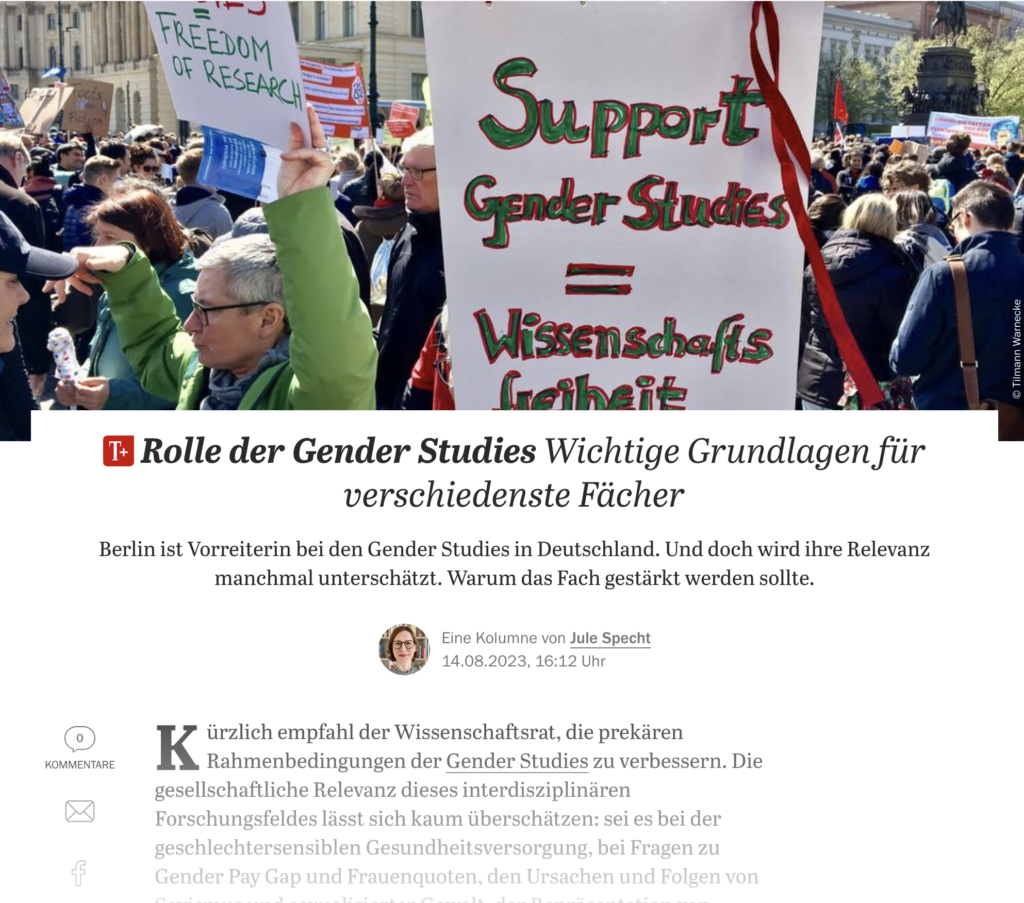
Documentary film screening and panel discussion with director Sohel Rahman and human rights activist Nickey Diamond
Organised by RePLITO/GAMS in collaboration with Heinrich-Böll-Stiftung, 23.06.2023.
Fritzi-Marie Titzmann
Sohel Rahman’s feature-length documentary „The Ice Cream Sellers“ („75“) tells the story of two young siblings and the survivors of the Rohingya genocide who fled Myanmar for Bangladesh. Amidst trauma and an uncertain future, the film’s two young protagonists, brother and sister, began their new lives with hard work: selling cheap ice cream door-to-door in the world’s largest refugee camp in a desperate attempt to earn enough money to bribe officials for their father’s release from prison in Myanmar. Their seemingly endless journey through the winding alleys of the camp is interspersed with brief encounters with other residents who give the filmmaker glimpses into their stories, with interludes of children playing or people observing their daily tasks. The colourful ice lollies are a beautiful symbol of moments of joy and pleasure in the midst of this devastating human tragedy.
Shot with a handheld camera, the film invites the viewer to become part of the children’s journey through the refugee camp in Cox’s Bazar, Bangladesh, just as the director himself was invited and given intimate access to their life journey.
The well-attended screening at the Heinrich-Böll-Stiftung was followed by a discussion between director Sohel Rahman and human rights activist and PhD scholar Nickey Diamond. Sohel is a filmmaker, writer and producer of Bangledeshi origin currently based in Lisbon, Portugal. His films have been screened at various international film festivals and universities around the world. He received the Best Documentary Award at the 2021 South Asian Film Festival in Montreal, Canada, and at the Tasveer South Asian Film Festival in Seattle for „The Ice Cream Sellers“, which he shot, edited and produced all by himself. In the audience discussion, he shared how intensive research and a long process of building trust eventually led to this film. Sohel approaches filmmaking from both an artistic and humanitarian perspective, incorporating his knowledge of literature, anthropology and life experiences.
He also announced a follow-up film he is currently working on, in which he revisits the camp.
Nickey added background on the current socio-political scenario in Myanmar, which has changed with the military coup of 2021. With the increasing atrocities now spreading from the discriminated minorities to the majority Burmese population, he hoped for more empathy and solidarity with the Rohingya and other minorities. Several questions from the audience addressed the question of how films can make a difference and a lively discussion developed about the international visibility of humanitarian crises and ways to show solidarity.
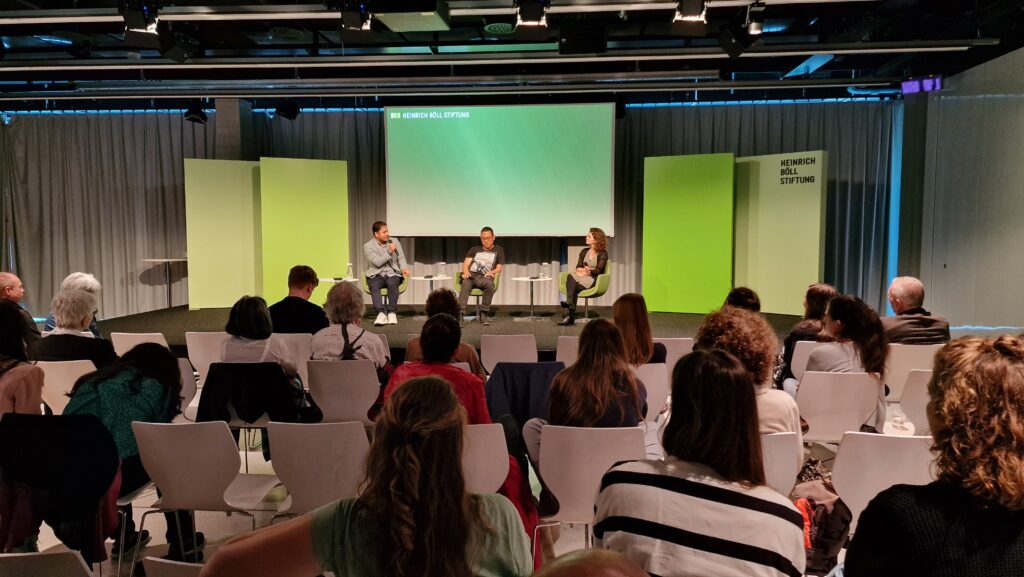
Anna Lena Menne, Makēda Gershenson & Alissa Steer
Have you ever genuinely stopped to consider how Information and Communication Technology (ICT) affects your life quality? While ICT, such as smartphones and the internet, are omnipresent in our daily routines, many of us fail to truly comprehend their impact on our social reality. As such, ICT remains an enigma or a so-called “black box” to many. However, the reality is that ICTs are not impartial entities. They are products of powerful individuals who bring their own values and biases to their creation and therefore perpetuate social inequality and reinforce historical structures, such as colonial dependencies. As a result, socially privileged individuals tend to reap more benefits from digitization, while marginalized groups are often left at a disadvantage. To make matters worse, personalized tech devices and content are tailored to individual preferences, but the power dynamics within the networked systems that govern other devices remain hidden. Altogether, these issues pose a universal challenge – how can we all freely and safely navigate the digital world with self-determination?
Digital Positionality and Epistemic Justice in the Digital Age
The digital age is rife with inequalities that hinder our ability to achieve true emancipation. Epistemic inequality, which manifests as knowledge gaps between individuals and between ICT creators and regular netizens, only exacerbates this issue. Our research tutorial is an innovative solution to address these knowledge gaps head-on. X-Tutorials are a type of research tutorial facilitated by the Berlin University Alliance, led by students for students, that provide an opportunity to experiment, develop, analyze, research, or evaluate self-organized projects with other like-minded individuals. Our group, linked to the department of Gender and Media Studies for the South Asian Region (GAMS) at the Institute for Asian and African Studies (IAAW) at Humboldt-Universität zu Berlin, is committed to promoting epistemic justice, a goal that we aim to achieve by introducing the concept of digital positionality.
Digital Positionality refers to the unique online environments of individual users and how they impact life opportunities. When engaging with ICT, our social identity and position shape the challenges and opportunities we face as we navigate our lives in a digital age. The ultimate objective of our research tutorial is to affect change at both the individual and systemic levels by designing a tool that empowers individuals to reflect on their digital positionality. This way, we hope to transform our digital experiences and those of others, fostering a more just and equitable digital world.
From Accessibility to Empowerment: Action, Collaboration, and Student Research
When it came to designing our tool, we knew that we could not simply impose our own ideas on others. Instead, we needed to gain a deeper understanding of people’s diverse digital experiences to create design principles that would be truly effective. To do this, we asked ourselves a crucial question: how can we make the concept of digital positionality accessible and meaningful to netizens, who often encounter complex technological structures through highly individualized interfaces and are sometimes misled by myths surrounding technology’s rationality? This was the key challenge we tackled in our project, inspired by a Participatory Action Learning and Action Research (PALAR) approach emphasizing collaboration and critical thinking.
Our journey began in the winter semester of 2022 at the IAAW Institute and will continue into the current summer semester of 2023. In an action learning group comprised of diverse student netizens, we sought to address the research problem that directly affects us in order to improve the digital experiences of ourselves and others. Rather than presuming to know what is best, we approached the project with open minds and in adherence to the design justice network principles, we prioritized listening to and understanding individual experiences. PALAR differs from traditional research approaches, which emphasize validity and reliability. Instead, we measure our research quality by the transformative effect of the project and consider all interactions towards achieving the project goal as data. These interactions include group meetings, field discussions, participatory strategies, and reflective journals kept by group members, all of which aim to ensure ethical conduct and personal transformation. By using this approach, we aspire to design a tool that truly reflects the needs and experiences of diverse people.
In October 2022, we initiated a cyclical action research process. Our work started with exploring the theoretical foundations of digital positionality and then examining and reflecting on our own experiences with ICT and digital positionality. To better understand the experiences of individuals from diverse and often underrepresented backgrounds, we developed research methods that were inclusive and responsive to their needs. Although our project was limited in scope due to the constraints of our university course, we evaluate its success based on the principles of PALAR. In other words, we measure the extent to which our work has empowered us as student researchers, the individuals with whom we have interacted throughout the research process, and ultimately the success of the tool we plan to create in the summer semester.
Fieldwork: Exploring Diverse Digital Positionalities
We embarked on an extensive fieldwork phase in January 2023. Our first method of inquiry was the Chatterbox, an electronic can phone developed by the Design Research Lab in Berlin, which enabled us to digitally gather and process ideas, questions, and comments on the digital sphere. With the help of a computer voice named Hans, our correspondent of the digital sphere, we interviewed approximately 60 individuals from various social milieus around Berlin, including a university and a workplace for people with disabilities, to assess their needs in reflecting on their digital positionality. We then conducted a focus group discussion with seven individuals from diverse positions in the social hierarchy, ranging in age from 24 to 72, with different identities, physical and mental abilities, and social classes, using a combination of spectrum and open-ended questions to explore issues of digital inequality and identify similarities and differences in their digital positionalities. Lastly, we organized two creative workshops for digital natives aged 11 to 14 at a community school in Berlin, teaching them about ICT and providing them with a space to reflect on their own experiences in the digital world.

Berliners‘ Perceptions of the Digital World: Beyond Established Discourses
Our conversations with people in Berlin revealed that the dominant European media discourse about the digital world significantly influenced their perspectives. Their concerns reflected issues like losing face-to-face interactions, excessive reliance on technology, addiction, and cyberbullying. They also expressed apprehensions about surveillance, data privacy, and the excessive power of large corporations in the digital realm. At the same time, the positive aspects of ICT were framed in terms of efficiency and rationality. Thus, to facilitate a more nuanced understanding of people’s relationship with digital technology beyond established discourses, our project requires an interactive educational component that emphasizes both ICT’s positive and negative aspects. Additionally, we envision the tool as open-source and easily accessible, emphasizing personal reflection and self-awareness and providing users with independent guidance to navigate the reflective process.
Avoiding Self-Reflection: The Cycle of Technology Use and Shame
People are heavily reliant on ICT, and they consider it a vital aspect of their daily lives. However, they tend to view technology’s benefits in terms of simplicity, convenience, or even laziness, rather than reflecting on how it enhances their quality of life. Although the European discourse agenda has raised awareness about the negative effects of ICT, most people continue to use it without engaging in genuine critical reflection. This, as we observed, leads to feelings of guilt and a perceived loss of self-efficacy among participants. During our focus group discussion, individuals acknowledged their high dependence on ICT with a negative connotation but were hesitant to delve into why. Instead, many devised rationalizations for their behavior, thereby bypassing self-reflection. This cycle of avoidance perpetuates the passive use and development of technology without addressing its adverse effects.

Some common ways that Berlin participants avoided reflecting on their ICT use and alleviated guilt and shame: acknowledging their dependence, but feeling too entrenched in it to break free, downplaying the negative aspects of technology, finding comfort in hearing that others share similar experiences, and even experiencing withdrawal symptoms when separated from their devices. There are numerous issues with this behavior of ours, but to highlight the most straightforward one: humans are the creators of technology, which means we have the ability to shape it to benefit us rather than just accepting the negative consequences as unavoidable. Taking the cycle displayed above one step further, we could compare it to psychological patterns of addiction. To address these issues, our tool must provide a reflective journey that is fun, creative, and affectively, emotionally, and behaviorally engaging. It should also help individuals identify self-exploitative dynamics and offer ways to maintain and heal throughout this reflective transformation while encouraging personalized self-assessment through shared socio-digital experiences.
The Transformative Potential of Shared Digital Experiences
The importance of shared experiences in our highly personalized digital world was a crucial factor in unlocking the transformative potential of our research project. Our primary goal was to gauge the effectiveness of our research by measuring the transformation of both our research group and the individuals we engaged with. We found ourselves and our participants expressing their gratitude, feeling empowered, and sharing their insights with their social networks as a result of engaging with our research, which was one of our greatest successes so far. Our focus group discussion further emphasized the importance of acknowledging the digital experiences of others, as demonstrated by a participant who found voice control on their phone annoying but recognized its significance for a blind person:
“For them (points to a blind person), it’s natural that voice control is better than for me. I’m currently struggling to… how can I explain it… understand these different perspectives. What is very annoying for me is important for others.” Therefore, our tool should promote engagement with various perspectives. It should also encourage sustainable digital self-determination by fostering creativity and providing resources for individual and collective societal transformation in the digital age. Most importantly, it should remain open to new ideas and continuously evolve through user input.
Fostering Sustainable Digital Self-Determination: Ten Principles for a Reflexivity Tool

Going forward, we will focus on these ten principles in the final X-Tutorial semester at Humboldt University to create a reflexivity tool that will support our pursuit of epistemic justice and contribute to important conversations about ethics and social justice in the digital age. If you have any inquiries, want to join us or wish to contact us for another reason, please feel free to reach out.
About the authors:
Anna Lena Menne is a Master’s student at Humboldt-Universität zu Berlin, where she tutors and co-researches digital positionality. Her critical research explores global transformation processes, focusing on digitization and the historical context of information societies’ epistemology/ontology and contemporary configurations of domination, order, and inequality. She completed her Bachelors’ in Media and Communications from Freie Universität Berlin and spent a partner semester at the University of Pretoria and Chulalongkorn University in Bangkok. Contact
Makēda Gershenson is a co-researcher of digital positionality. She is a Master’s candidate in the Futures Research program at Freie Universität. She holds Bachelor’s degrees in Psychology and German Studies as well as a Master’s degree in Education from Stanford University, in addition to an Executive MBA from Quantic School of Technology. Her work focuses on emotional intelligence, equity and community-based interventions, bringing contemplative practices into educational settings. She trains school leaders, educators and organizations in social-emotional learning and mindfulness and supports individuals as a digital behavioral coach. Contact
Alissa Steer is a co-researcher of digital positionality. She is doing her master’s degree in Media and Political Communication at Freie Universität Berlin. Her research focuses on critical theory, platforms, and hegemony. She is a student assistant in the research group Politics of Digitalization at the Berlin Social Science Center. Here, she combines her experience from her Bachelor’s degree in Media Research from Technische Universität Dresden and a semester at Universitat Abat Olibat Barcelona with her research interest in the impact of patriarchy, imperialism and capitalism in the digital age. Contact
„Crouching Tigers and Invisible Dragons: Representation of Desi Chinese in Indian Popular Cinema“
by Nadja-Christina Schneider
Lawrence Liang, professor of law at Dr. Ambedkar University Delhi, is well known as an academic, public intellectual and activist who has worked on issues such as Intellectual Property, Law and Public Culture, Free Speech as well as Media and Technology. However, he has hardly spoken publicly about the Indian Chinese or Desi Chinese community, to which Liang himself belongs. The thematic focus of this year’s Mother Language Day event on ‚Transcultural Encounters with Chinese communities, languages and cultures in Asia and Africa‘ on February 21, 2023 offered him a framework to speak for the first time on the topic of representation of Desi Chinese in post-independent Indian cinema.
In his fascinating lecture, which was supplemented by very interesting film stills and clips, Liang first gave an overview of more than seven decades of post-Independence film history, which is predominantly characterized by an absence or highly stereotypical representations of Indian Chinese. Absence also in the sense that Indian Chinese characters were rarely played by members of this community. If the question of representation were to be limited solely to the portrayal of individual characters, Liang argues, then this story would quickly come to an end. Much more interesting for him, therefore, is the question what the films reveal about the coexistence and historical context in which they are set or which the film plot addresses.
Feature films shot in the 1950s in particular, whose plots are set in earlier decades, convey much about a degree of mobility that viewers obviously took for granted as something which existed at the time between the port cities and adjacent regions of the Bay of Bengal, as well as a related form of cosmopolitanism in Indian cities, which was finally brought to an end by the establishment of nation-state borders after the end of the British Raj. As a film which, just a few years before the Sino-Indian Border War of 1962, shows a form of friendly bonding and solidarity beyond gender, caste, class, and ethnic boundaries in 1930s Bengal as a possibility, Mrinal Sen’s film Neel Akasher Neechey (Under the Blue Sky, 1959) stands out. It is also remembered today as the first film in independent India to fall victim to censorship:
Only many decades later, more precisely in the feature film Tubelight (dir. Kabir Khan), released in 2017 and set at the time of the 1962 war, Lawrence Liang again sees another rare film moment in Indian cinema that gives space to the idea of friendship and solidarity with the Indian Chinese. This time perhaps also motivated by a Chinese film market which is extremely promising for Indian films, and according to media reports in India was one of the reasons for casting Chinese actress Zhu Zhu in the female lead role.
Several years were to pass again before the episode Mumbai Dragon (dir. Vishal Bhardwaj) in the anthology Modern Love Mumbai (2022), streamed on Amazon Prime, also created a cinematic opportunity for the first time to make the long-taboo subject of the internment of three thousand Desi Chinese in the prison camp in Deoli in Rajasthan discussable. Singer, actor and presenter Meiyang Chang, who in this episode plays the role of a young man whose mother can only gradually adjust to his relationship with a young Gujarati woman, made an important statement when he publicly spoke out against cases of racial discrimination to which members of marginalized communities in India were particularly exposed during the Corona pandemic.
Together with his sister Jennifer Liang, Vidura Jang Bahadur, Jenny Pinto and Koel Chatterjee, Lawrence Liang has created the remarkable online archive Desi Chinese Project, which is an important knowledge resource on the long history and present of Desi Chinese in India. As Lawrence Liang mentioned in the discussion after his insightful talk, he hopes that this archive can eventually be adopted and continued by the whole community.
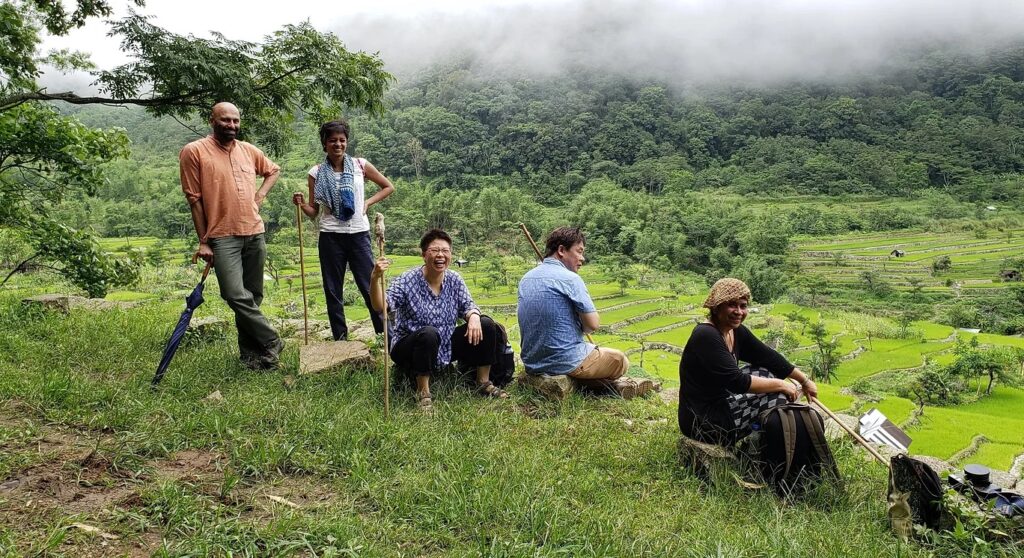
von Lara Kauter
Im Rahmen meines Masterstudiums in Geographischer Entwicklungsforschung an der FU habe ich ein zweiwöchiges Lehrforschungsprojekt in Kooperation mit der Freien Universität und der Guwahati University durchgeführt. Gemeinsam mit zwei Dozenten sind 20 Studierende aus meinem Master nach Guwahati in Assam (Indien) gereist, wo wir zusammen mit 10 Studierenden der Guwahati University in kleineren Forschungs-Teams eigene Forschungsprojekte durchgeführt haben. Im folgenden Blogbeitrag berichte ich von unserem Projekt zu Problemen in der Agrarwirtschaft in Assam, und wie unerwartete Wendungen während der Feldforschung auch eine Chance zur Neuausrichtung und Bereicherung von Projekten sein können.
Assam liegt im Nordosten Indiens an der Grenze zu Bhutan und ist als eines der größten Teeanbaugebiete weltweit bekannt. Der Tee-Anbau in der Region findet seinen Ursprung im britischen Kolonialismus, als Tee zu einem globalen Handelsgut und Alltagsgetränk wurde. Die kolonialen Teestrukturen prägten das heutige Assam und die seitdem weitgehend unveränderten Produktionsweisen in der indischen Teeproduktion: Abholzung von Waldgebieten, Arbeitsmigration, Verdrängung, und Ausbeutung von indigenen Völkern in den Teeanbaugebieten stellten die koloniale Norm der Teeproduktion dar. Kulturell, sprachlich und religiös betrachtet ist Assam divers: es werden Assamesisch, Bengalisch, Hindi, Bodo und weitere Sprachen gesprochen, sowie dort Hindus, Muslime, Buddhisten, Christen, Jains und Sikhs leben. Ethnische Konflikte treten insbesondere im Zusammenhang mit muslimischer Zuwanderung aus Bangladesch auf, welche durch ein zunehmendes Maß an Fremdenfeindlichkeit geschürt werden. In Assam leben auch verschiedene indigene Bevölkerungsgruppen, die als Scheduled Tribes klassifiziert werden. Die größte Gruppe der indigenen Bevölkerung sind die Bodo, die eine Regionalautonomie über die Bodoland Territorial Area Districts in Assam haben.1
In Vorbereitung auf das Lehrforschungsprojekt haben wir uns im Sommersemester in zwei Seminaren mit der (Kolonial-)Geschichte, Gesellschaft und Kultur Indiens und Assams befasst und uns projektspezifisch für unsere jeweiligen Forschungsvorhaben vorbereitet. Gemeinsam mit meiner Kommilitonin Elena habe ich mich für ein Projekt zur Agrarkrise Indiens und lokalen alternativen Bauernmärkten in Guwahati entschieden. Unser Forschungskonzept sah vor, dass wir zwei Formen von Bauernmärkten (Regierungs- und NGO-Markt) auf institutionelle, räumliche und sozio-ökonomische Aspekte untersuchen und dabei die aktivistische Perspektive einer lokalen Graswurzel-Bauernbewegung namens Krishak Mukti Sangram Samiti (KMSS) einbeziehen. Unser Ziel war es herauszufinden, wie beide Marktkonzepte im Vergleich zu üblichen Gemüsemärkten funktionieren und inwiefern sie eine lokale Alternative für die Lebensgrundlage der Bauern und Bäuerinnen im Kontext der Agrarkrise schaffen.
Am 24. September 2022 startete das Forschungsprojekt offiziell und wir trafen uns mit unseren Dozenten an der Universitätsunterkunft in Guwahati. Die meisten FU-Studierenden nutzten die Gelegenheit, um bereits vor unserem Projektbeginn durch Indien zu reisen, sodass wir bei unserem Wiedersehen viele Reisegeschichten austauschen konnten. Am selben Abend lernten wir auch die indischen Studierenden kennen und konnten so die ersten Feldforschungstage gemeinsam planen.
Die ersten Projekttage verbrachten wir damit, zu viert (Dharitry, Elena, Parishmita und ich) die insgesamt sechs Regierungsmärkte (Krishakor Dukan) ausfindig machen zu wollen, von denen wir die ungefähren Standorte aus der offiziellen Regierungswebsite entnahmen und diese auch telefonisch von einem Kontakt bereits Monate zuvor bestätigt bekommen hatten. Zu unserer Überraschung war dies jedoch schwieriger als gedacht, da wir trotz zeitintensiver Suche keinen der Märkte auffinden konnten und erst nach erneutem Telefonat mit dem Organisator eines Marktes erfuhren, dass alle Regierungsmärkte zwei Monate vor unserer Ankunft geschlossen wurden. Diese Erkenntnis war zunächst ziemlich enttäuschend für unser Team, da wir unser gesamtes Forschungsprojekt auf diese Märkte ausgelegt hatten. Wir beruhigten uns damit, dass wir ja immer noch den NGO-Markt von NE-SAFE (Krishakor Bazaar) untersuchen könnten, der sich jedoch auch nicht als das herausstellte, was wir erwartet hatten. Während der Organisator in einem Telefoninterview Monate zuvor enthusiastisch erzählte, wie dieser Markt Bauern und Bäuerinnen im Verkauf und Transport ihrer Produkte unterstütze und faire, profitable Preise sicherstelle, fanden wir bei unserer Ankunft lediglich eine leere, kommerziell genutzte Verkaufsfläche vor. Der einzige dort verkaufende Bauer erzählte uns zudem, dass der Markt-Organisator korrupt sei und er keinerlei Unterstützung von der NGO bekommt, wie sie auf der Website der NGO angepriesen wird.
Mit diesen Erkenntnissen setzten wir uns zu viert zusammen und überlegten bei einer Tasse Masala Chai und assamesischem Thali, wie wir mit diesen unerwarteten Wendungen weiter vorgehen könnten. Unser neuer Forschungsschwerpunkt sollte nun auf den Problemen in der indischen Landwirtschaft liegen und auf der Frage, warum die Konzepte von urbanen Bauernmärkten offensichtlich scheiterten. Wir arbeiteten ein neues Forschungskonzept mit vier Untersuchungsebenen aus: Regierungsebene, Aktivismusebene, praktisches Level (Perspektiven von Bauern/Bäuerinnen und Händler:innen), sowie NGO-Arbeit und alternative Ideen für die Landwirtschaft.
Überraschenderweise fiel es uns nicht schwer, spontan ein neues Konzept auszuarbeiten. Dharitry und Parishmita konnten über ihren Dozenten schnell Märkte ausfindig machen, bei denen wir die Gelegenheit bekommen würden, mit Bauern/Bäuerinnen über Probleme in der Landwirtschaft zu sprechen. So besuchten wir an drei Tagen ländliche Märkte außerhalb der Stadt, wo wir viele Kleinbauern und –bäuerinnen antrafen, die ihre Produkte dort selbst verkauften. Zwei weitere Tage verbrachten wir auf einem urbanen Gemüsemarkt im Stadtzentrum Guwahatis, wo wir jedoch keine Bauern/Bäuerinnen antrafen, dafür jedoch mit Händler:innen über Probleme des Marktsystems sprechen konnten. Insgesamt interviewten wir auf allen Märkten rund 40 Personen; viele der befragten Landwirt:innen haben gleichzeitig ein zweites Standbein im Gemüsehandel, da Landwirtschaft alleine keine Lebensgrundlage für die meisten bietet. Die prekäre Situation im Agrarsektor wurde uns von Bauern und Bäuerinnen geschildert: Dürren und Fluten, das Fehlen von Maschinen und Bewässerungssystemen, sowie ein Mangel an Geld und fehlender Unterstützung der Regierung führt zu finanzieller Ungewissheit und Verlusten. Zudem werden Produkte durch fehlende Kühlhäuser schnell schlecht, und Bauern/Bäuerinnen machen aufgrund der Anwesenheit vieler Zwischenhändler:innen kaum Gewinne durch den Verkauf ihrer Produkte.
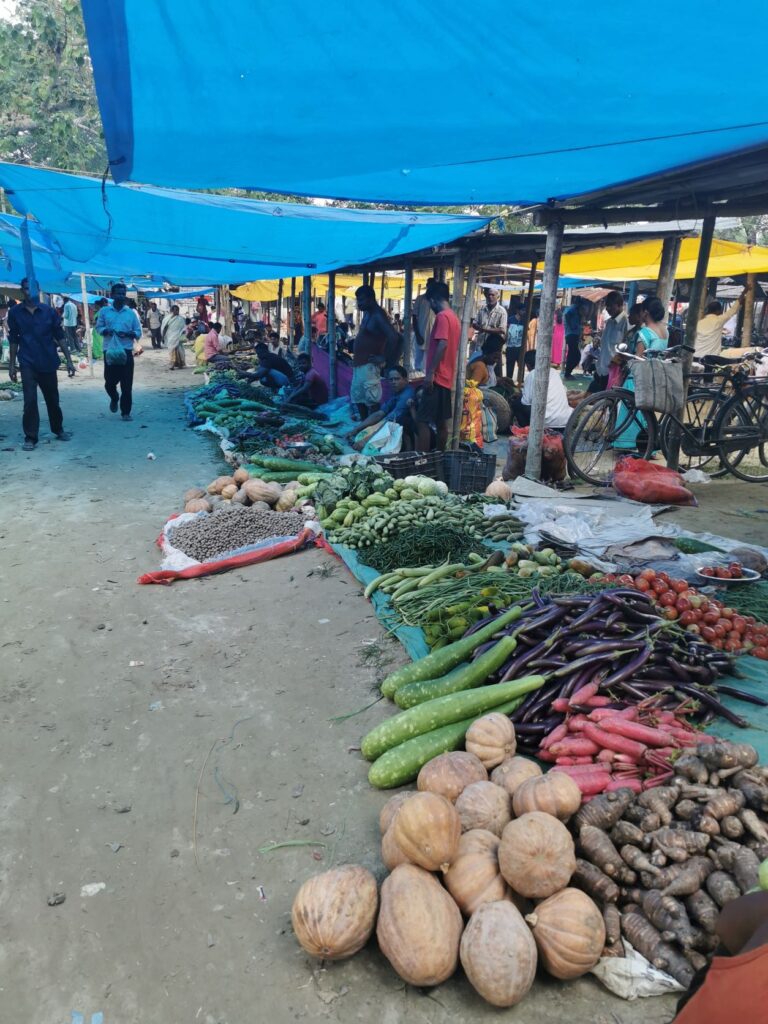
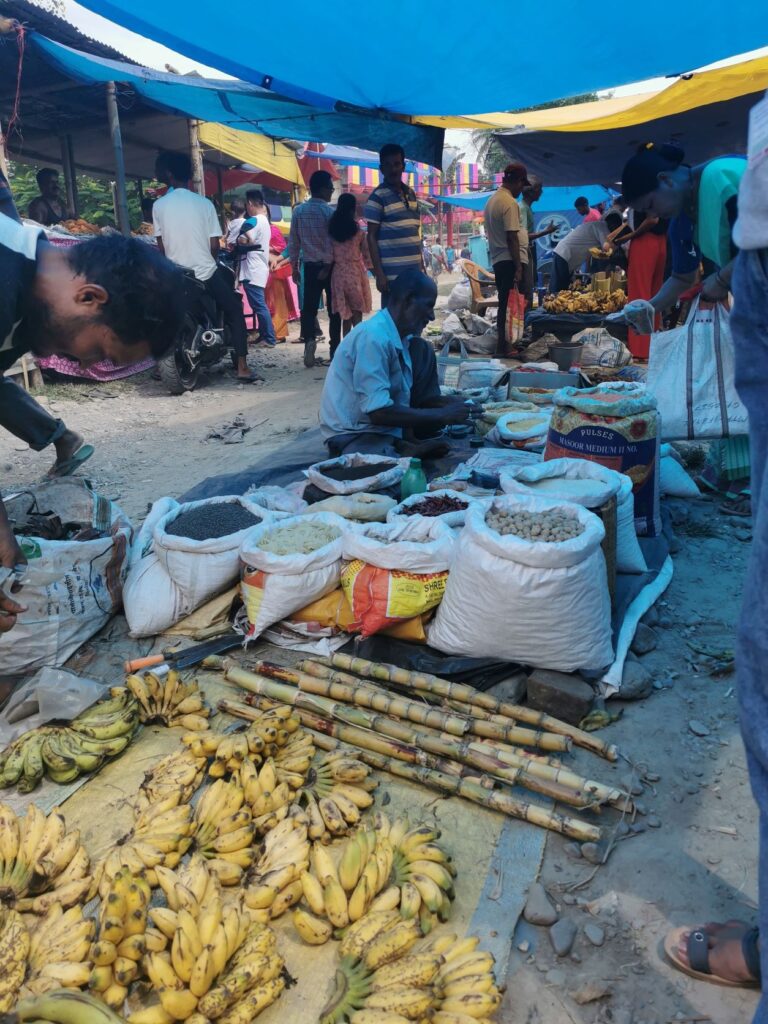
Für die Aktivismusebene stellten wir über Facebook Kontakt zu der lokalen bäuerlichen Graswurzel-Organisation Krishak Mukti Sangram Samiti (KMSS) her und wurden für ein Interview zu ihnen ins Büro eingeladen. Wir sprachen mit dem Generalsekretär von KMSS und dem Präsidenten des Studierendenflügels Satra Mukti Sangram Samiti, sowie mit weiteren Mitgliedern der Organisation. Das Interview war für uns sehr besonders, da wir herzlich empfangen wurden und mit assamesischen Gamosas (Schals) geehrt wurden. Die Aktivisten kritisierten die Regierung scharf für die gegenwärtige Agrarpolitik und berichteten von ihren Protesten gegen Staudammprojekte, den Citizenship-Amendment-Act und die neuen Agrargesetze aus 2020. Über unsere Kontakte mit KMSS wurden wir auch zu einem Interview mit der KMSS-nahen Partei Raijor Dal eingeladen, die sich als links orientierte, auf Grundwerten des Sozialismus basierende, säkulare Partei beschreiben lässt. Raijor Dal steht in Opposition zur regierenden BJP in Assam und während des Interviews mit der Parteisprecherin, dem Pressesprecher und einem Parteimitglied, schilderten sie uns ihre Unzufriedenheit mit der gegenwärtigen Agrarpolitik, sowie ihre Lösungsvorschläge für die Probleme in der Landwirtschaft.
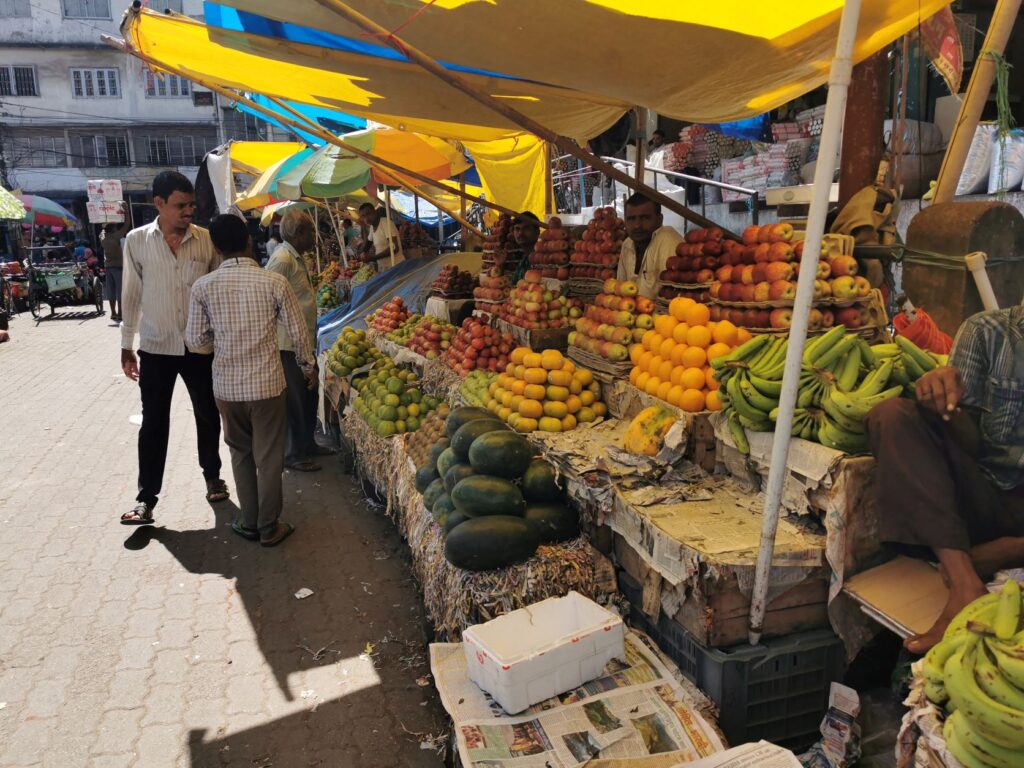
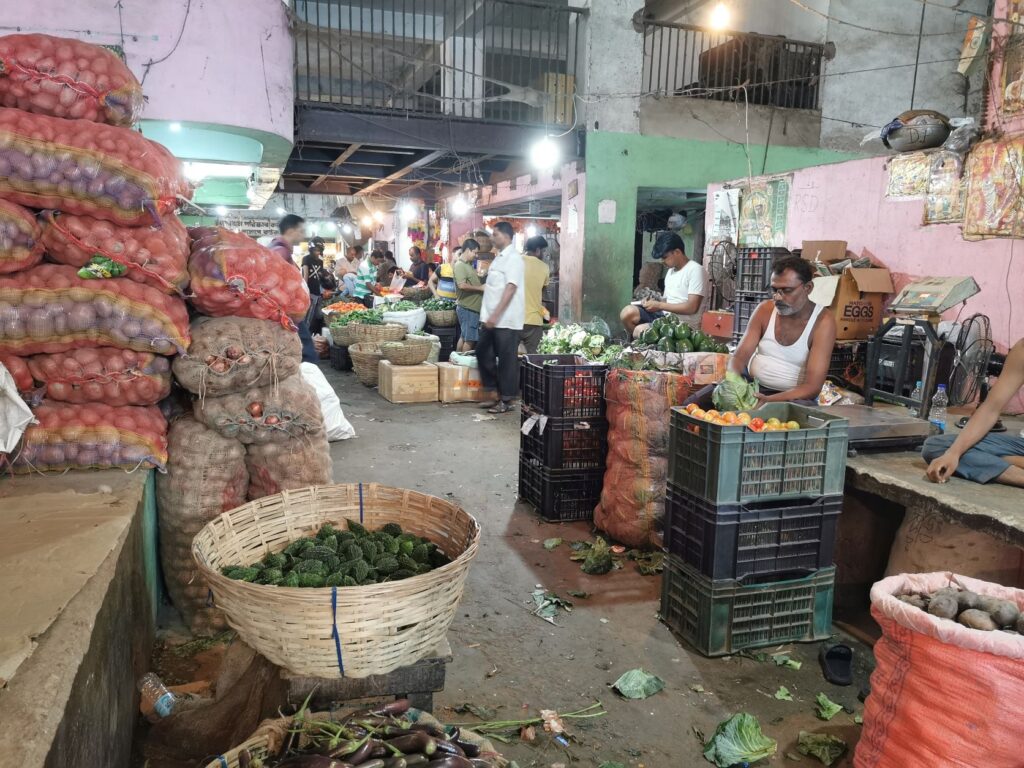
Um jedoch ein breites Spektrum an Perspektiven einzuholen, bemühten wir uns auch, ein Interview mit dem Assam Ministerium für Agrarwirtschaft zu führen, um die Regierungsperspektive zu verstehen. Zu unserer Überraschung lud der Amtsvorsitzende uns gleich für den nächsten Tag zu einem Interview ein, wo wir zunächst bei angespannter Stimmung in seinem Büro schweigend Tee tranken, da er Fragen erst nach dem Tee zulassen wollte. Zu unseren Fragen sind wir leider nicht gekommen, da er nach dem Tee-Trinken einen wichtigen Termin hatte. Unsere Fragen konnten wir aber an den Marketingassistenten stellen, sodass wir dennoch erfuhren, dass die sechs staatlichen Bauernmärkte aufgrund von befristeten Mietverträgen der Verkaufsflächen nicht mehr existieren, obwohl das Marktkonzept selbst erfolgreich und profitabel war. Darüber hinaus zeigte er sich auch sehr bewusst, was die Probleme in der Landwirtschaft angeht und kritisierte trotz seiner BJP-Nähe die Unionsregierung Indiens für fehlende finanzielle Mittel zur Unterstützung der Landwirt:innen und machte dies als Hauptgrund für die prekäre Situation in der assamesischen Landwirtschaft verantwortlich.
Für die NGO-Perspektive interviewten wir einen der Organisatoren von NE-SAFE, welche auch den Krishakor Bazaar unseres ursprünglichen Forschungskonzepts organisiert. Der Organisator erzählte uns zwar von seinen vielen Ideen für die NGO und wie sie Landwirt:innen helfen wollen, jedoch waren wir aufgrund des sehr leeren Erscheinungsbild des Marktes skeptisch, ob diese Ideen jemals umgesetzt werden. Aus diesem Grund suchten wir eine weitere NGO namens Sesta auf, die primär Frauen-Selbsthilfe-Gruppen gründet und auf diese Weise landwirtschaftliches Wissen mit finanziellen Ressourcen vermittelt, um die Lebensgrundlage und Unabhängigkeit von Frauen zu stärken. In einem Interview mit Mitarbeiter:innen erfuhren wir mehr über die Agrarprojekte der NGO und ihren Plänen, kommerzielle Landwirtschaft durch Gründung von bäuerlichen Erzeugerorganisationen und Firmen zu etablieren. Dieser Einblick in alternative Ansätze in der Landwirtschaft war für uns sehr spannend, auch wenn Selbsthilfegruppen als Strategien in der Entwicklungsforschung nicht unumstritten sind.
Insgesamt waren wir sehr erstaunt, wie einfach und schnell wir vor Ort Kontakte geknüpft und Interviewpartner:innen gefunden haben. Zudem sind wir dankbar für die Gastfreundlichkeit und Zeit, die sich unsere Interviewpartner:innen für uns genommen haben. Dennoch galt es auch einige Schwierigkeiten zu überwinden: insbesondere die Interviews mit Händler:innen und Landwirt:innen wären ohne Dharitry und Parishmita nicht möglich gewesen, da die meisten befragten Personen auf den Märkten kein Englisch sprachen. Neben der Sprachbarriere waren auch lange Anreisewege zu ländlichen Gemüsemärkten und Staus im Stadtzentrum mühsam.
Etwas ungünstig war auch der Forschungszeitraum von unserer Uni gelegt, da wir zum hinduistischen Fest Durga Puja dort waren und viele Büros, NGOs und Firmen für mehrere Tage geschlossen waren, und somit viele Projektteams ihre Forschung pausieren mussten. Andererseits war das ein sehr schöner kultureller Einblick, bei der Durga Puja mitzufeiern und die Feierlichkeiten in der gesamten Stadt zu beobachten. Während des mehrtägigen hinduistischen Fests wird die Göttin Durga für ihren Sieg über den bösen Büffeldämon-König Mahishasura verehrt. Die Feierlichkeiten enden am zehnten Tag, bekannt als Vijayadashami oder Dussehra, wenn heilige Bilder der Göttin Durga in großen Festzügen unter lauten Gesängen und Trommelschlägen zu den örtlichen Flüssen getragen werden, wo sie eingetaucht werden. Am selben Tag wird zudem eine große Statue von Ravan in Erinnerung an die berühmte Schlacht von Ram und Ravan verbrannt, was symbolisch an den Sieg des Guten über das Böse an diesem Tag erinnert.2
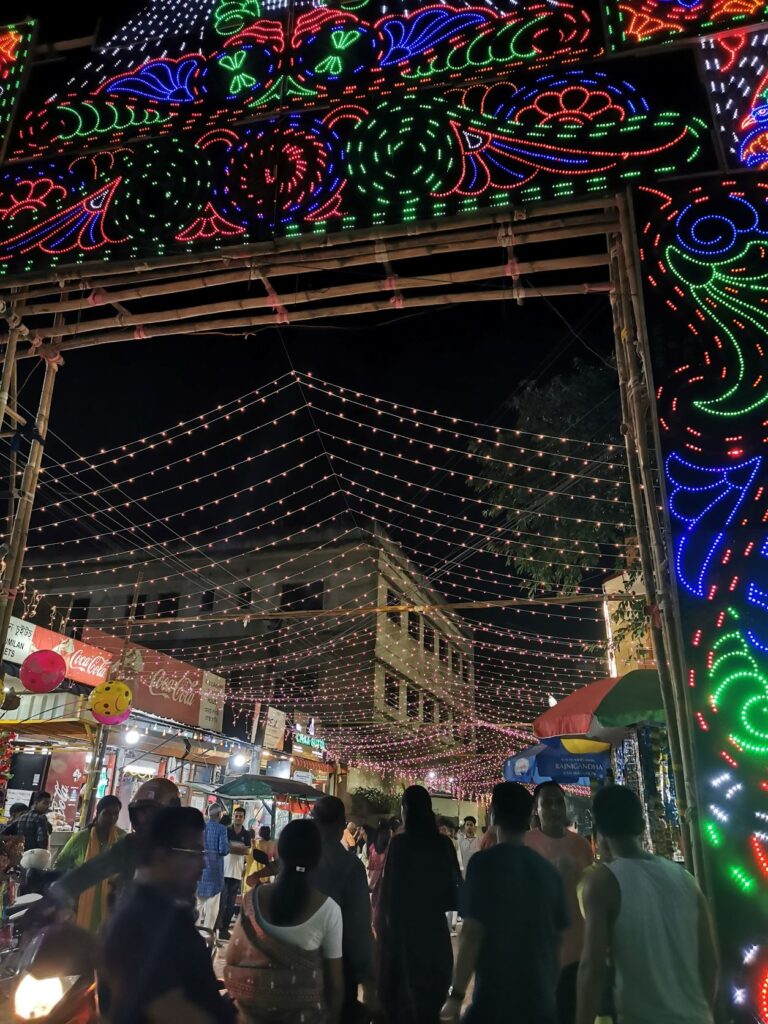
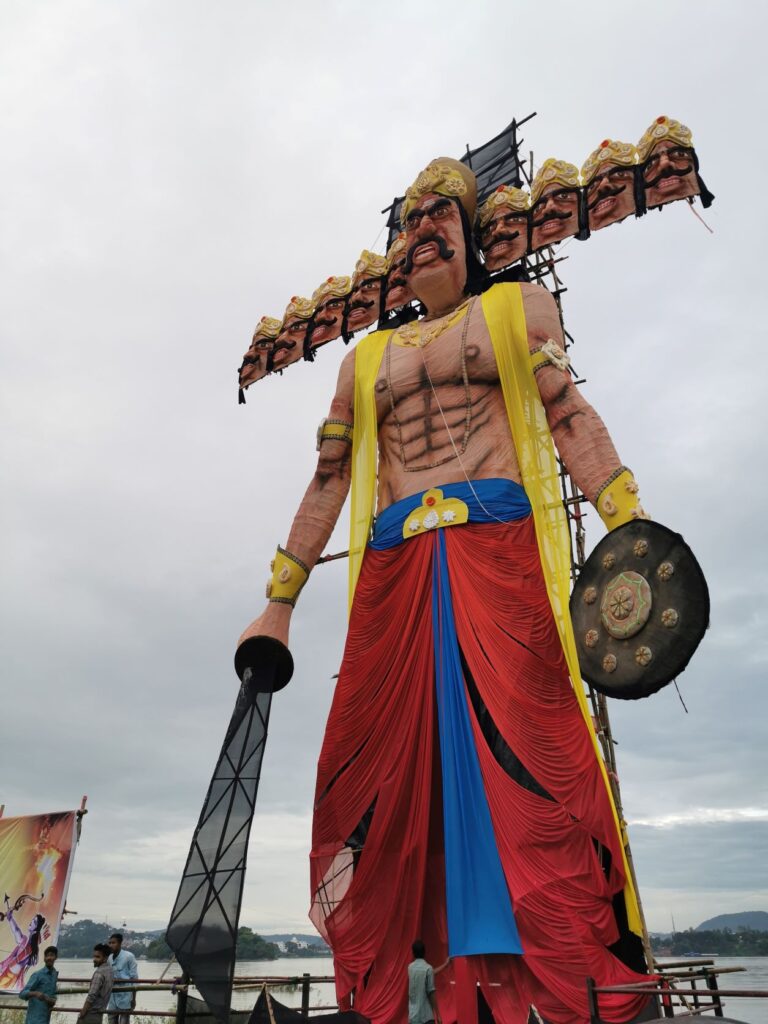
Mein Forschungsaufenthalt in Guwahati war definitiv das Highlight meines Masterstudiums und ich bin sehr dankbar für die schöne Zusammenarbeit in meinem Projektteam. Ein riesiges Dankeschön an Parishmita, Dharitry und Elena, dass wir stets gemeinsam Lösungen gefunden haben und bei der intensiven Forschungsarbeit so viel Spaß hatten. Ebenso ein großes Dankeschön an meine Dozenten Andrei und Stefan, die diese Kooperation erst möglich gemacht haben und so viel Vertrauen in unsere Projekte und Arbeit hatten. Für die finanzielle Unterstützung bedanke ich mich auch herzlich bei PROMOS. Die Erfahrung, ein Forschungsprojekt im Team zu planen und durchzuführen, war für mich sehr lehrreich und ich würde mir wünschen, dass diese Möglichkeit häufiger an Universitäten für Studierende angeboten wird.
1 Weiterführende Literatur zu Assam:
- Das, Nava Kishor. „Making of tea tribes in Assam: Colonial exploitation and assertion of Adivasi rights.“ Journal of Adivasi and Indigenous Studies 3.1 (2016): 1-16.
- Nath, Monoj Kumar. The Muslim Question in Assam and Northeast India. Taylor & Francis, 2021.
- Sharma, Chandan Kumar. „The Bodo Movement: A Preliminary Enquiry into the Role of the Middle Class and the State.“ Political Dynamics of North East India, New Delhi: South Asia Publishers (2000): 128-142.
- Sharma, Chandan Kumar. „The immigration issue in Assam and conflicts around it.“ Asian Ethnicity 13.3 (2012): 287-309.
- Sharma, Jayeeta. „‘Lazy’natives, coolie labour, and the Assam tea industry.“ Modern Asian Studies 43.6 (2009): 1287-1324.
- Xaxa, Virginius. „Need for restructuring the tea plantation system in India.“ Economic and Political Weekly, LIV 45 (2019): 31-36.
2 Weiterführende Literatur zu Durga Puja:
- Pallavi, Krishna Priya. “Durga Puja 2021: All You Need to Know about Significance, Date, History and Time.” Hindustan Times, 2021, https://www.hindustantimes.com/lifestyle/festivals/durga-puja-2021-all-you-need-to-know-about-significance-date-history-and-time-101633863409850.html.
Über die Autorin: Lara Kauter studiert Geographische Entwicklungsforschung (M.Sc.) an der Freien Universität in Berlin. Ihre Forschungsinteressen umfassen Globale Ungleichheit, Klimagerechtigkeit, Migration, Landwirtschaft und Protestbewegungen.
von Emily Engler



